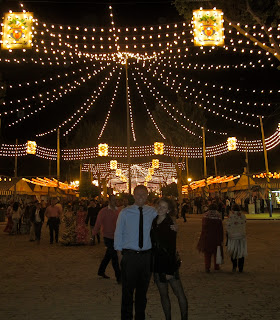The reason that I had the opportunity to travel this past week was because of our days off of school to celebrate la Feria de Abril. The event in English means "April Fair". Feria is an incredible display of the Spanish culture, and is known nation-wide as the party of the year. Spain's culture is exemplified as women dress up in incredible flamenco dresses, men put on their nicest suits, and everyone parties for what seems like 24 hours a day, 7 days of the week (my roommate came home one night at 5 in the morning, to which my host mom responded, in all seriousness, "you got home so early!"). Sevilla is the crown spot for Feria. Although other cities have celebrations similar to Sevilla's sometime in the summer, Sevilla's is known as the "madre de Feria", meaning that it is the original and greatest feria celebration in all of Spain.
You enter in the fairgrounds through the incredible front gate, known in Spanish as the parador (shown at the top of the post). It is original to the fair every year, and takes nearly 11 months to make. The massive fairgrounds are split within two sections: one half is your traditional fairground. There are probably around 100 rides, games, and even merry-go-rounds with live ponies! There are also food stands where you can buy churros, waffles topped with whipped cream or ice cream (aka gofres), and buñuelos, which are basically just fried balls of goodness.
 |
| Churros on the bottom, and buñuelos on the top. |
 |
| Spain style merry-go-round. |
The second half of the fairground is full of casetas, or well-decorated covered tents. Every caseta is decorated intricately, and every one is unique. Some of them have chandeliers hanging from the ceiling, others have hand-painted murals on the walls. Most of the casetas are private and family-owned, passed down from generation to generation. Others are public, but are not quite as elegant. Each caseta has its own unique personality, but it seems as though nearly every single one had a stage for flamenco and live music alongside of it.
Everyone drinks rebujuito, which is a mixture of manzanilla wine and 7-up. Rumor has it that they mix it with 7-up because it is refreshing during the hot days, and manzanilla by itself is a little too much to handle... People eat, drink, dance, and be merry all throughout the week. No one works. No one sleeps. Everyone gets their Spain on.
The week of festivities quite literally ended with a bang, as Feria was capped off with a 4th of July-esque fireworks show on the river that could compete with some of the best in America.
Although I feel as though I have become pretty accustomed to the city and culture, Feria was one of the first times in a while that I felt like a true outsider and tourist. I was in absolute amazement of the dresses, casetas, and most of all, the parador.
I believe that Sevilla is truly the ambassador of the Spanish culture. Experiencing Feria de Abril this past week solidified that belief.
Brad.
















































